Anselm Kiefer at Palazzo Strozzi puts us at the center of his mental universe
For some time now, Florence has been striving to redesign its artistic identity by opening up to the contemporary, not an easy inclusion in a city whose imagination is universally linked to the historical wonders of which it is the repository. Exemplary in this regard is the choice to periodically host in Piazza della Signoria, not without controversy, monumental sculptures by Jeff Koons (2015), Urs Fischer (2017), Jan Fabre (2016) and Francesco Vezzoli (2021), invited to measure themselves against one of the most complex and coveted scenarios for artists from around the world. The most recent exhibition programming of the Fondazione Palazzo Strozzi also seems to converge in this perspective, as it is gradually intensifying in its schedule the presence of major international names, such as Ai Weiwei (September 23, 2016 - January 22, 2017), Bill Viola (March 10, 2017 - July 23, 2017), Marina Abramovi? (Sept. 21, 2018 - Jan. 20, 2019), Tomás Saraceno (Feb. 22, 2020 - Nov. 01, 2020), Jeff Koons (Oct. 2, 2021 - Jan. 30, 2022), Olafur Eliasson (Sept. 22, 2022 - Jan. 22, 2023), Yan Pei-Ming (July 07, 2023 - Sept. 03, 2023), and Anish Kapoor (Oct. 07, 2023 - Feb. 04, 2024). Complementing what seems to be consolidating as a distinctive format of the institution is the presence of site-specific interventions on an environmental scale made by the protagonists of the exhibitions within the historic courtyard, the enjoyment of which is offered to the gaze of the citizenry and the tourist populace regardless of the purchase of the ticket required to access the upper floors. Competing with the attractiveness of the greatest exponents of medieval and Renaissance art by proposing great masters of contemporary art who are also loved by the general international public: this seems to be the current orientation of Fondazione Palazzo Strozzi to contribute to the hoped-for contemporary “renaissance” of Florence. Whether it is a lasting direction or a transitional phase preparatory to a future opening to support artistic research, it is certainly a frontal operation and not without contradictions. The most evident tensions appear to be related both to the valorization of the specificities of the historical palace, a refined 15th-century architectural jewel with which dialogue is invoked each time, and more generally to the idea of responding to the creative excellence stratified over the centuries in the city with the temporary importation of articulate devices of wonder always at risk of being conceptually pre-packaged. Also fitting into this context is the striking new exhibition currently underway, Anselm Kiefer. Fallen Angels, dedicated to Anselm Kiefer, the living contemporary artist who perhaps more than any other has linked his expressiveness to a monumental interpretation of space prone to sucking every structural pre-existence into his own overwhelming aesthetic universe. And perhaps because of this, we shall see, it is also one of the most successful exhibitions from the point of view of the symbiosis between the works and their setting.
The exhibition itinerary, then, as we expect (and previous exhibitions, particularly Anish Kapoor and Reaching for the Stars. Maurizio Cattelan to Lynette Yiadom-Boakye, have accustomed us well!), opens in the courtyard with Engelssturz (Fall of the Angel), 2022-2023. The subject of this painting, over seven meters high, is the expulsion of the rebellious angels from Paradise at the hands of the archangel Michael, an episode from Revelation usually associated with the struggle between Good and Evil. The work, from whose title derives that of the entire exhibition, is in many ways paradigmatic of the German artist’s poetics, whose symbolic and expressive scope is indelibly inscribed in matter and its alchemical transformations. First and foremost, the colossal dimensions, associated with a structural (we might say ontological) solidity that predisposes his works to be exposed to atmospheric weathering without suffering in substance, while remaining available to accommodate the morphological and chromatic changes they may cause. Then that peculiar layering of materials that, since the 1990s, has expanded his concept of painting with the inclusion of earth, dried plants, ashes, straw and other objects whose mutual settlements and conflicts transform each work into a titanic epic of matter. Such insertions manifest Anselm Kiefer’s aptitude for reworking the world’s waste through a relentless process of construction, demolition and reconstruction in which even history, specifically German history in the aftermath of World War II, becomes a moldable material. At the same time, the meaning attributed to each of these elements is to be interpreted more as an allusion to the increasingly culturally omnivorous artist’s multiple philosophical, literary and scientific interests than as components of a precise symbolic device calibrated to the individual work.
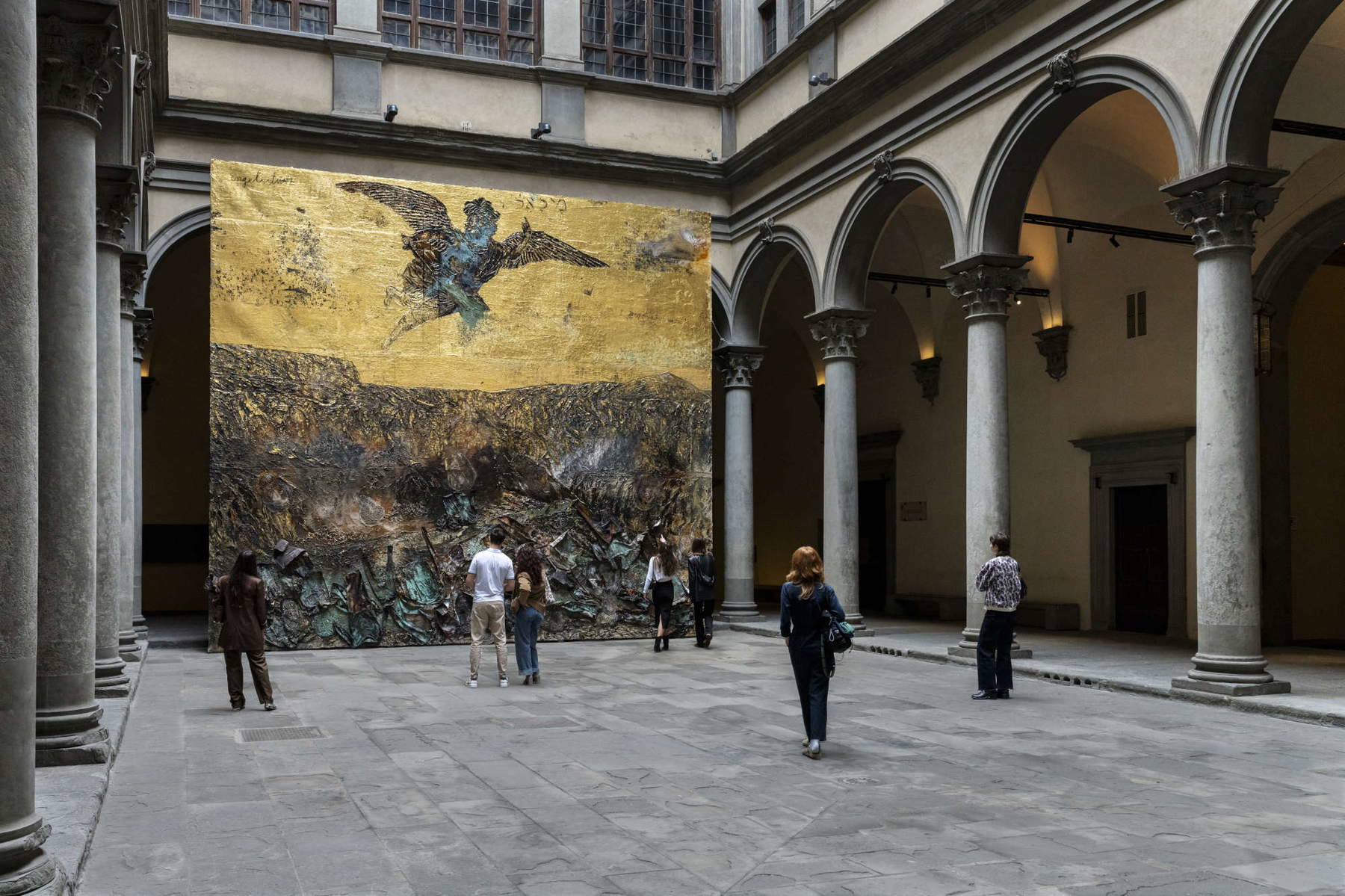
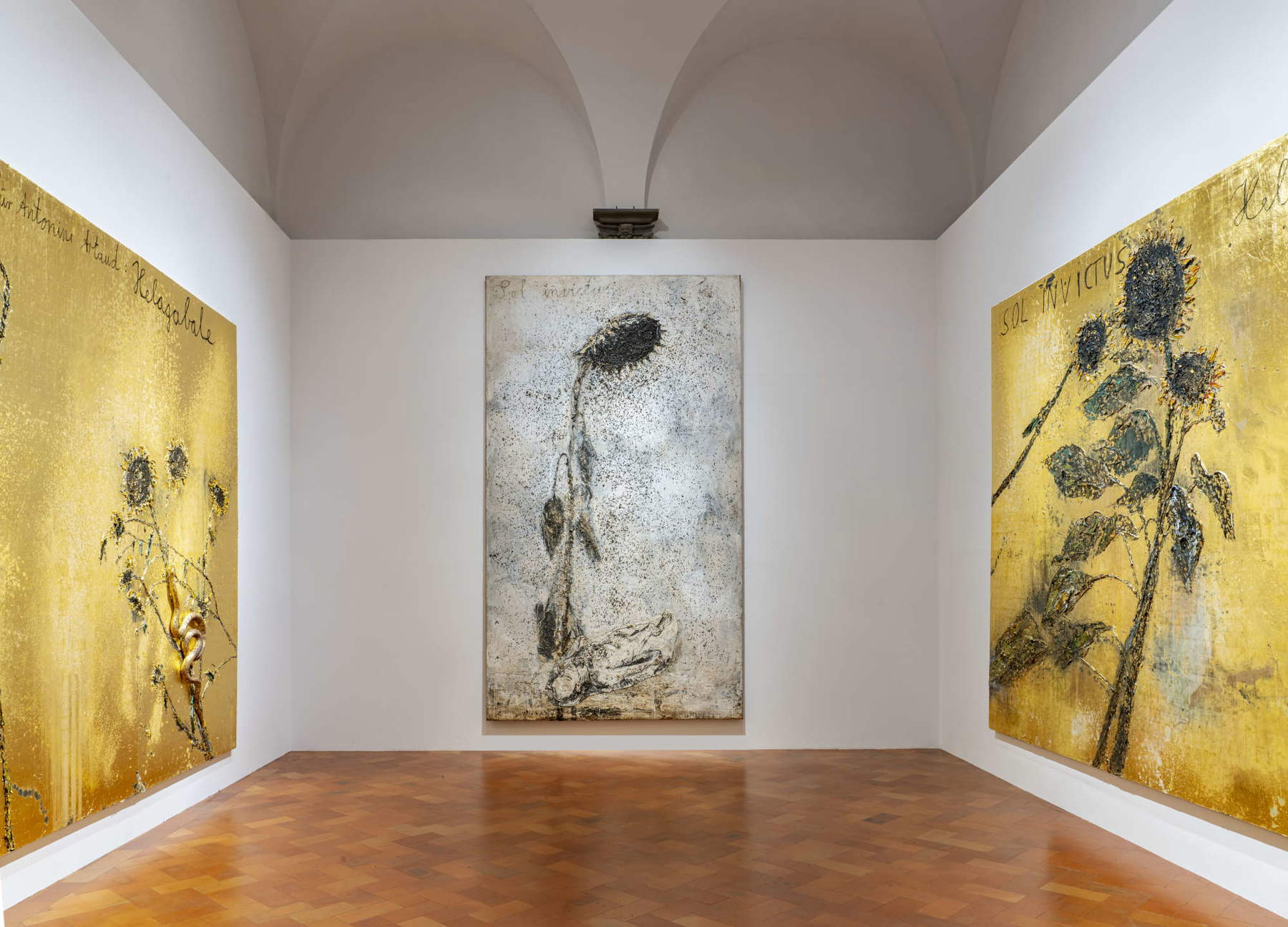
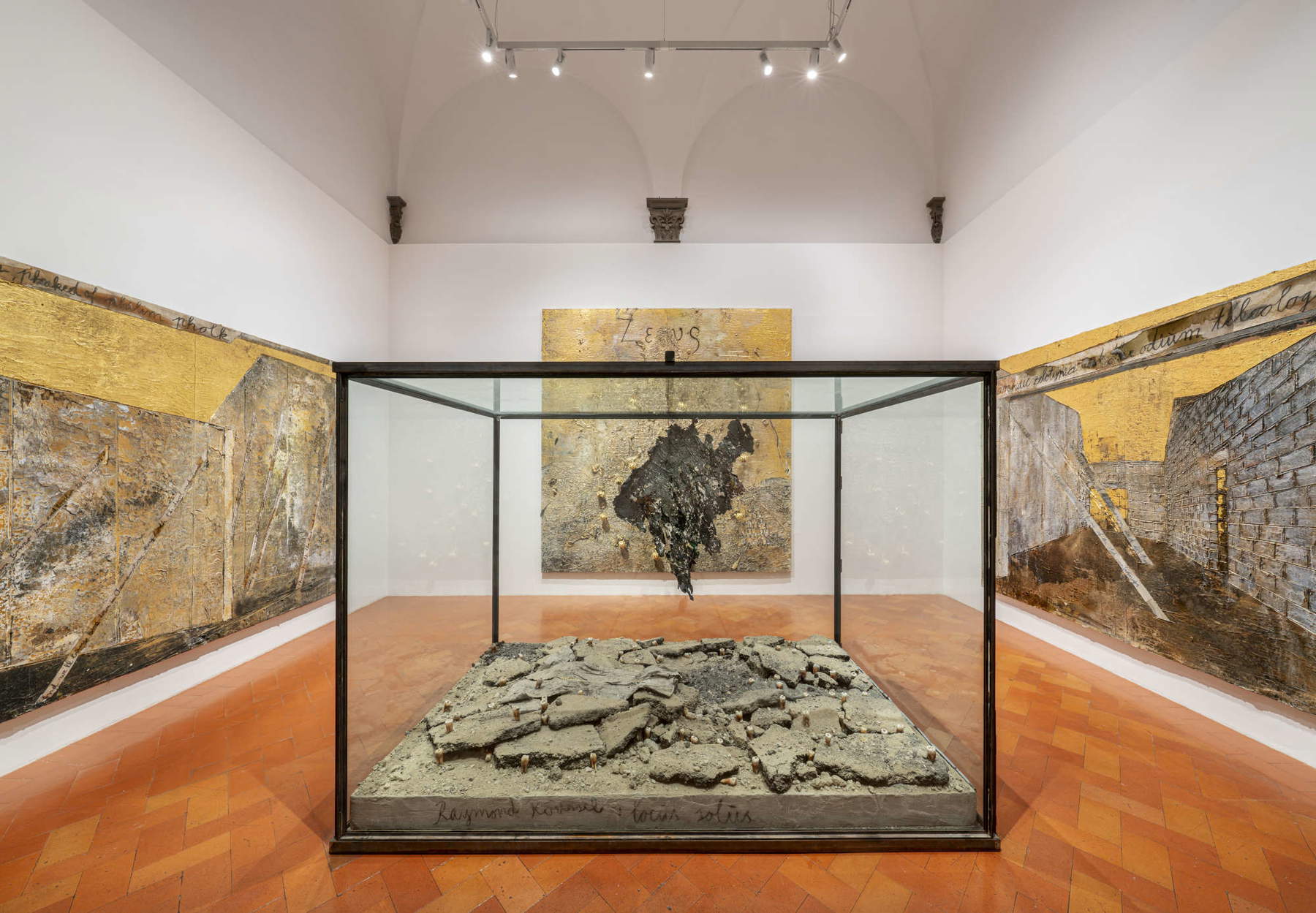
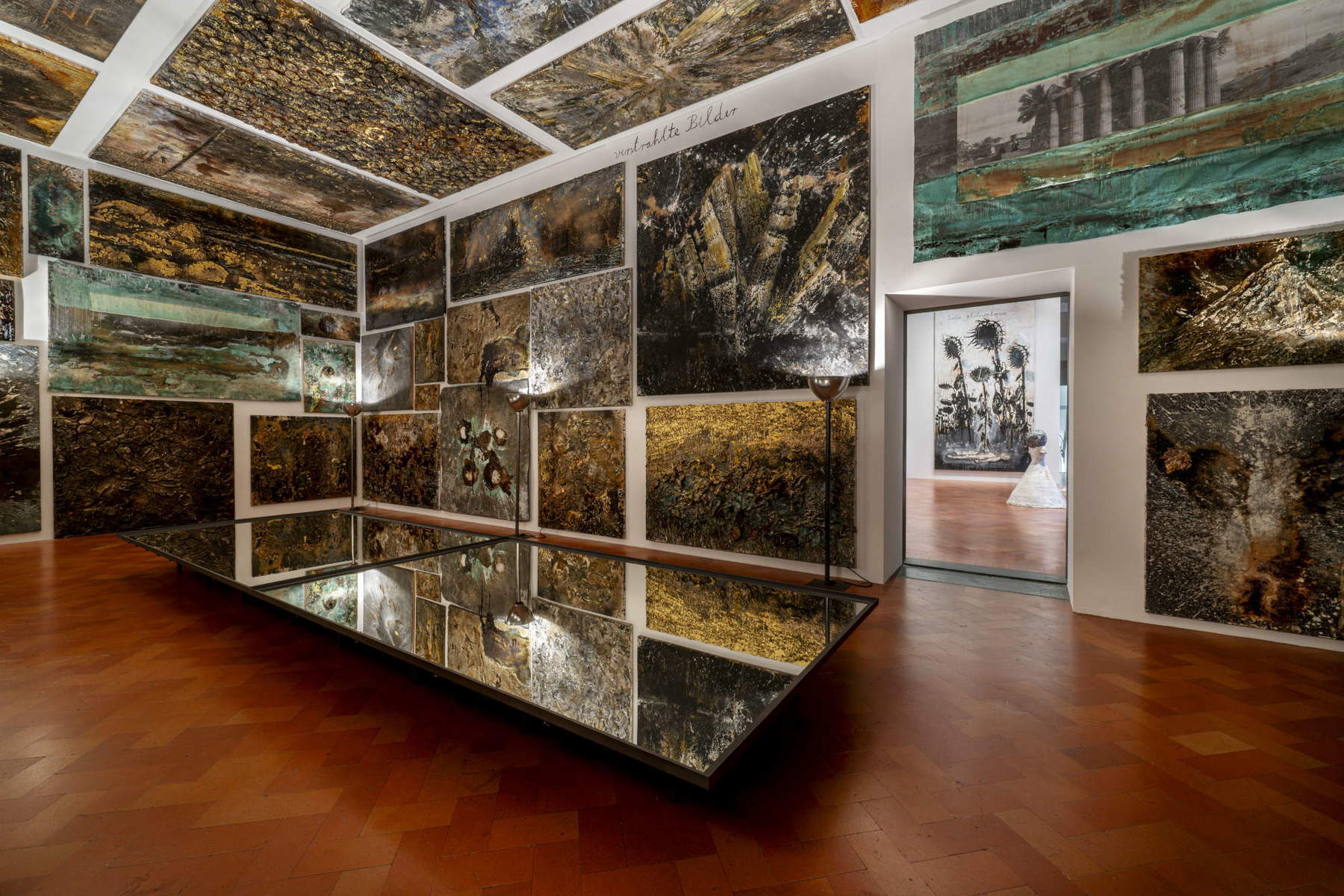
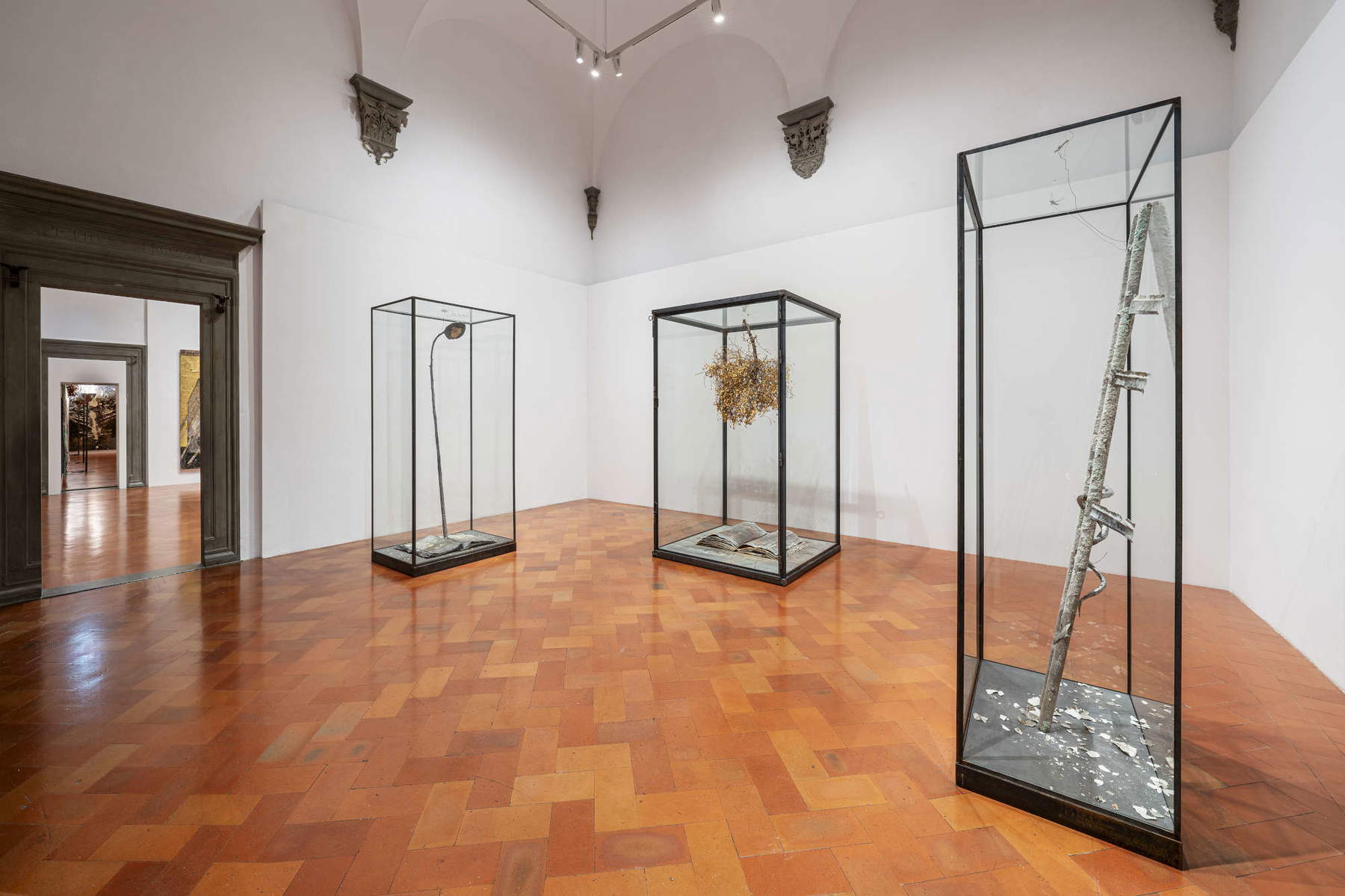
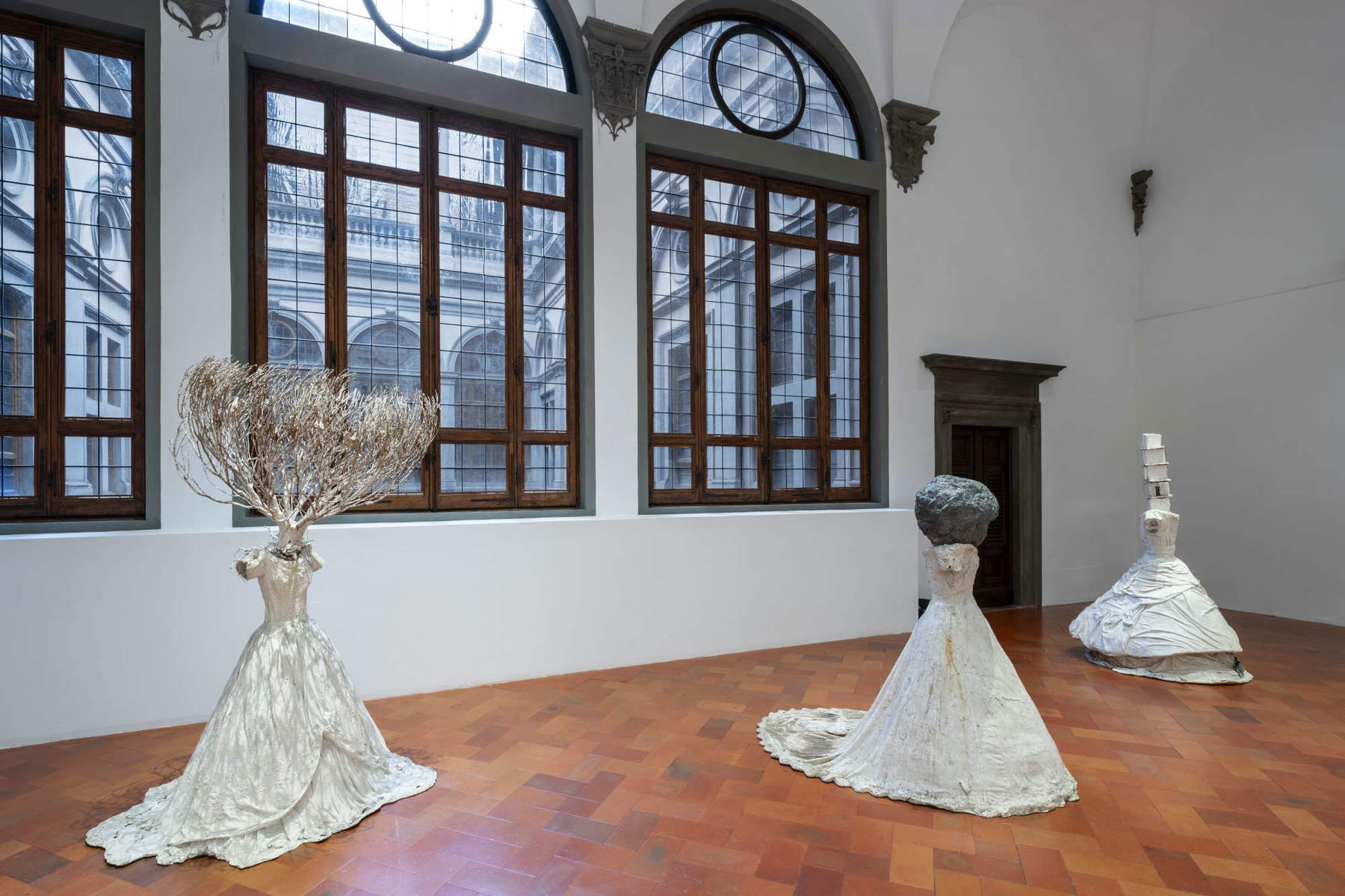
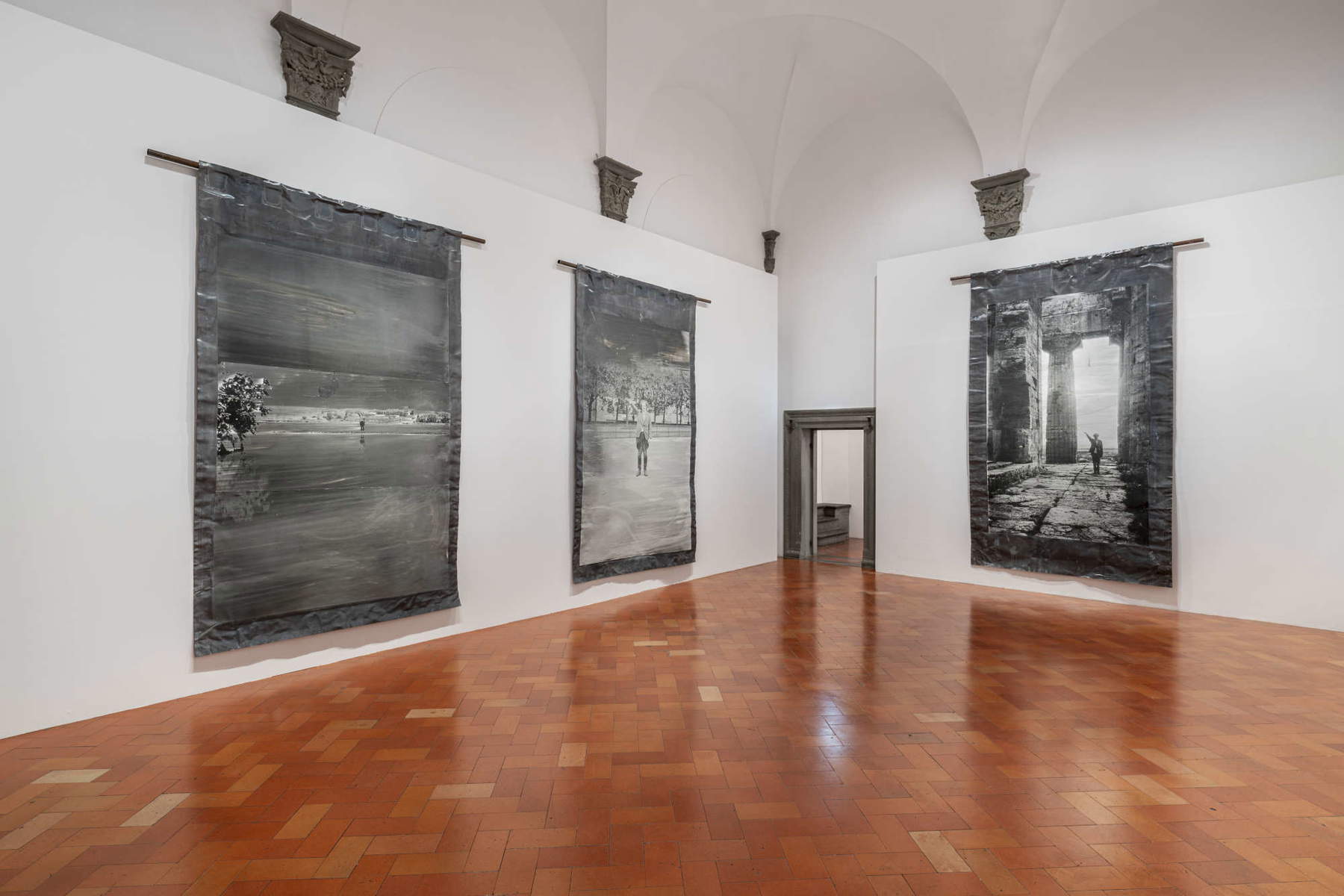
The underlying question underlying all his production is, in fact, always the same, namely the ultimate meaning of our being in the world. This quest, sparked at the beginning of his career by the desire to immerse himself in the horror of the then recent German history by breaking all paralyzing reticence, over time has turned decisively toward the Hegelian category of totality. A universalist aspiration of this magnitude and the inexhaustibility of the question from which it is sustained are certainly not within the reach of everyone, and Anselm Kiefer’s greatness lies precisely in this, in being able to confront the immeasurable and the unspeakable without coming out defeated, on the contrary always drawing new life from the same impossibility. Thus, if on the one hand, looking at one of his boundless paintings is like seeing them all, from the point of view of the dazzling insight of the existential question that in their presence overwhelms us almost as much as the aesthetic impact, on the other hand, each work in itself appears as a teeming fragment of the infinite, ready to regenerate itself at each new glance from us.
And again, finally, the constant presence of the written word, with that cursive calligraphy, now made iconic by its fame, recalling schoolchildren’s exercises on notebook pages with lines containing the letters. The familiarity with writing, born of the never-abandoned habit from his youthful years of jotting down his life in a diary, naturally flowed into his artistic practice, along with a fascination with books, considered both as a source of knowledge and as signifying objects in themselves. In Engelssturz , therefore, the title of the work appears traced in the upper left-hand corner, while the word identifying the main character is written on the right in the Hebrew alphabet, testifying to how widespread and deep the cultural syncretism that fuels his poetics is.
So let us enter the main floor to visit the exhibition, which has the merit of scanning in a non-didactic but exhaustive itinerary (as far as it is possible with an artist so tireless and fecund in his productivity) the main areas on which his research hinges. In the first room stands Luzifer (2012-2023), an ideal continuation of the opening painting in which we see Lucifer’s plummet into the underworld of a bumpy, suffering matter in which the angels who preceded him are alluded to by empty tunics in partial decomposition. Heaven is no longer the incorruptible gold background of Engelssturz, but a sickly oxidized blue-green obtained by subjecting materials to electrolysis processes. In this struggle between Good and Evil, philosophically traceable to the duality between the spiritual essence of the soul and its embodiment in matter, there seem to be no winners and losers, but a fatal and cyclical interdependence. In Negative Dialectics (1966), Theodor Adorno, an author of reference for the artist, declares, “After Auschwitz, no poetry, no art form, no creative statement is possible anymore.” If the archangel Michael’s wing here is a real, pointed, dented airplane wing stretching into the space in front of it, a wartime relic insignia of destruction and death, the artist’s response to the impossibility stigmatized by the Frankfurt philosopher lies in the delicate compromise between chaos and order of which each of his works is a provisional manifestation. Thus, not beauty as a resolving sublimation, but the vertigo of multiple possibilities always unfolding on a space-time scale that transcends the boundaries of the human and the artist’s daily commitment to grasping and reworking their connections without ever asserting himself as the regulating demiurge of an artificial final arrangement.
We then enter another breathtaking room, dedicated to theRoman emperor Heliogabalus, a founding character in Kiefer’s artistic cosmogony since the 1970s. Of Syrian descent, Heliogabalus was, by hereditary right, the high priest of the sun god (El-Gabal) and, when he was acclaimed emperor by the Eastern troops in opposition to Macrinus, he attempted to replace Jupiter, lord of the Roman pantheon, with the new deity of Sol Invictus, who had the same attributes as the solar god of Emesa, his city of origin. Facing each other here are two full-wall paintings entirely covered in gold leaf, on each of which huge sunflowers stand out, interspersed with a white vertical canvas in which an equally monumental sunflower spills its (real) seeds in a rain shower over a man lying on the ground. These flowers, powerful symbols of death and rebirth dear to him because of their connection to pagan festivals celebrating the victory of light over darkness and the assimilation of their seeds to the constellations of the cosmos, are ubiquitous in his poetics. Fascinated from a young age by their decadent appearance at the moment of full bloom, making them a symbol of the human existential condition, the artist planted in the greenhouses of his studio-residence in Barjac, France, a particular Japanese variety that produces oversized flowers, which are often included in his paintings and sculptural installations.
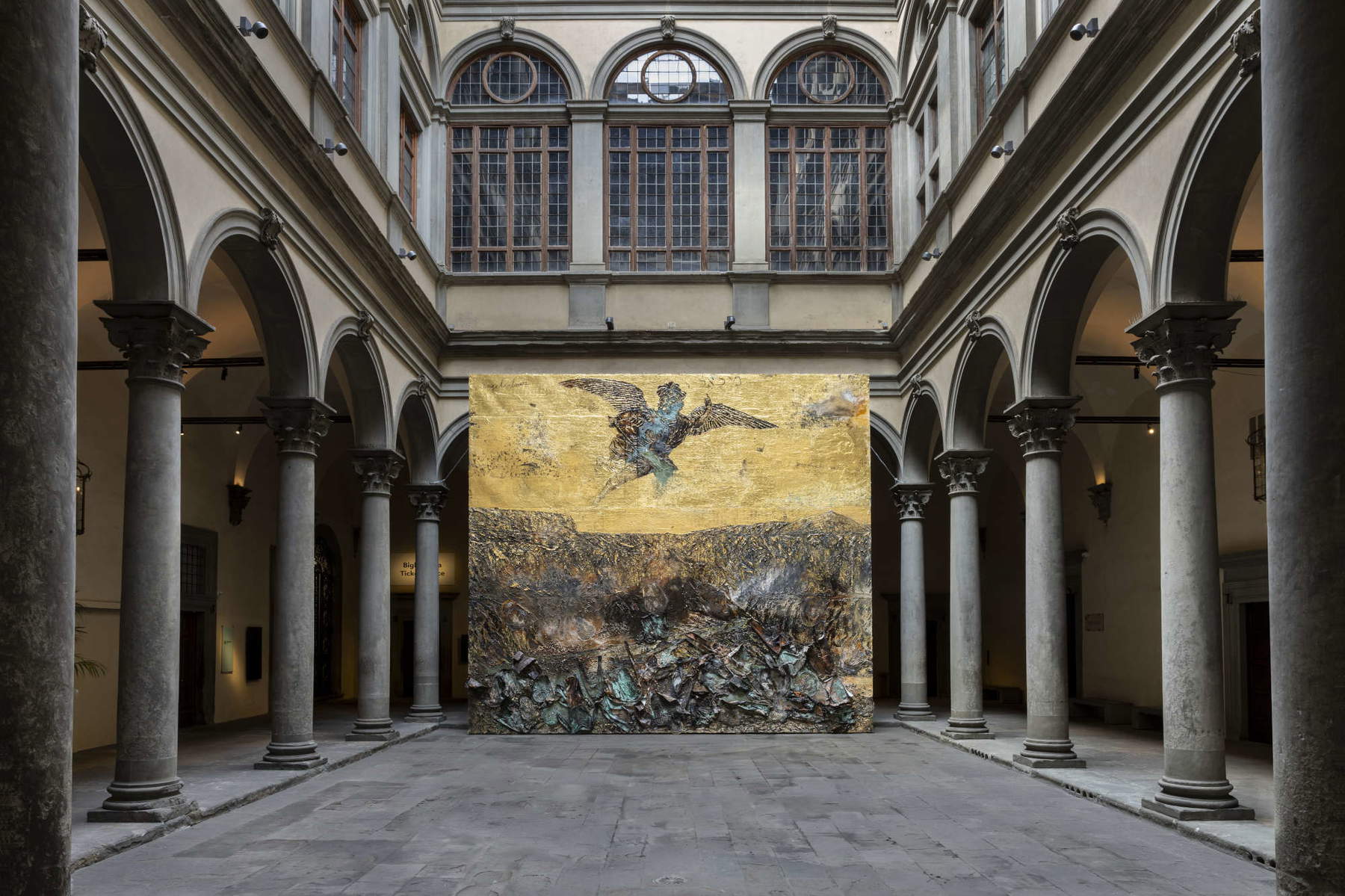

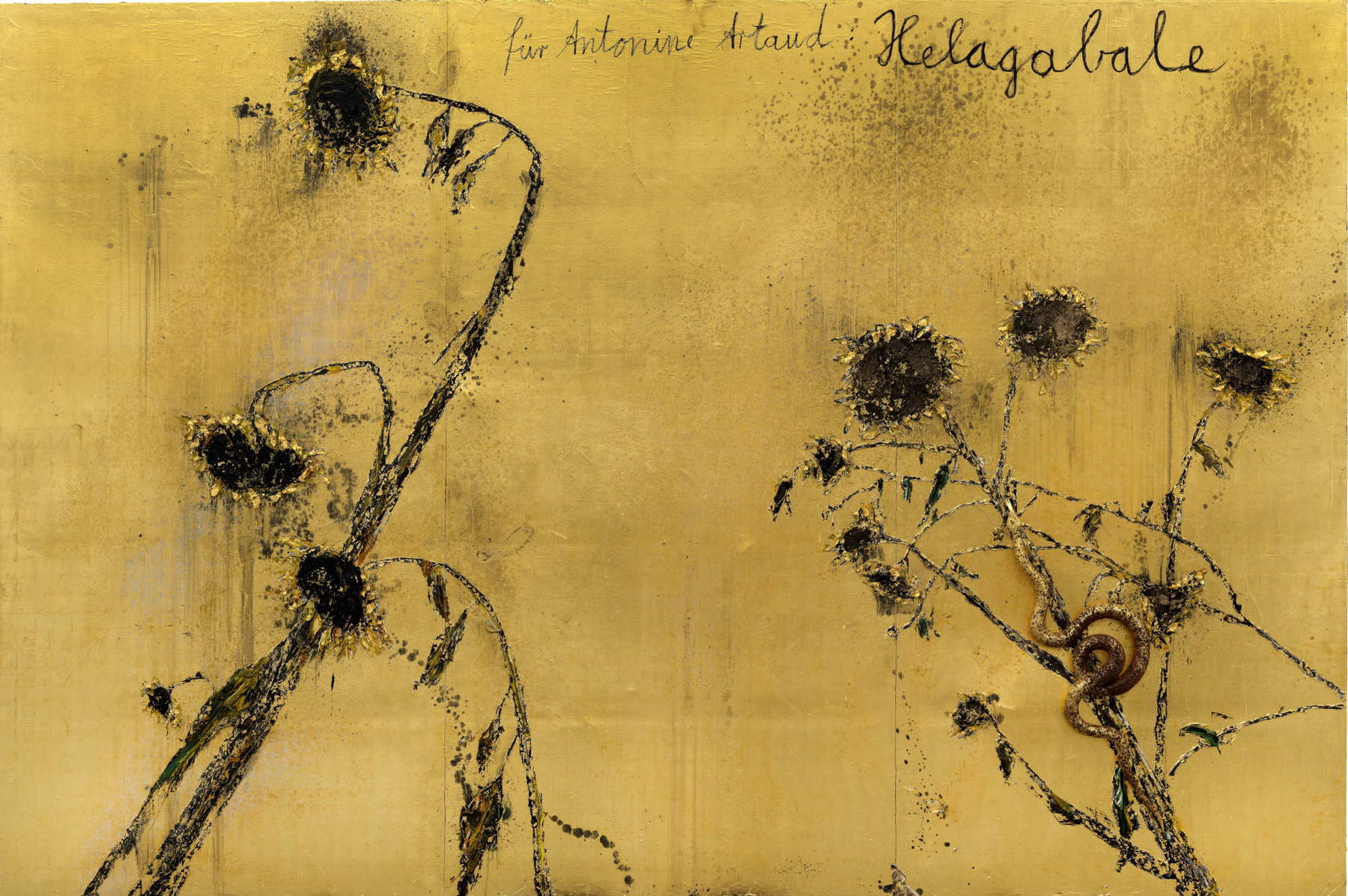
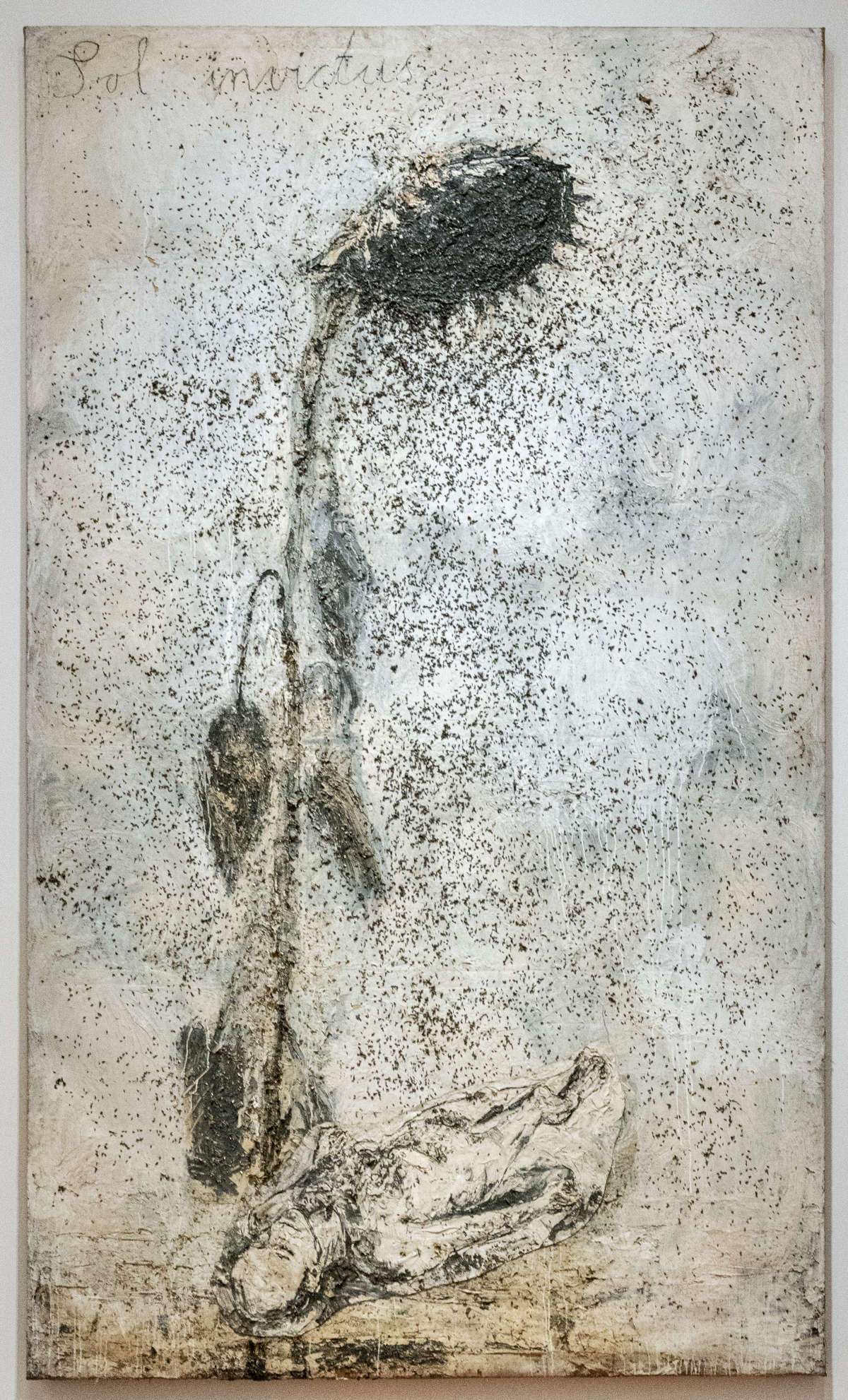
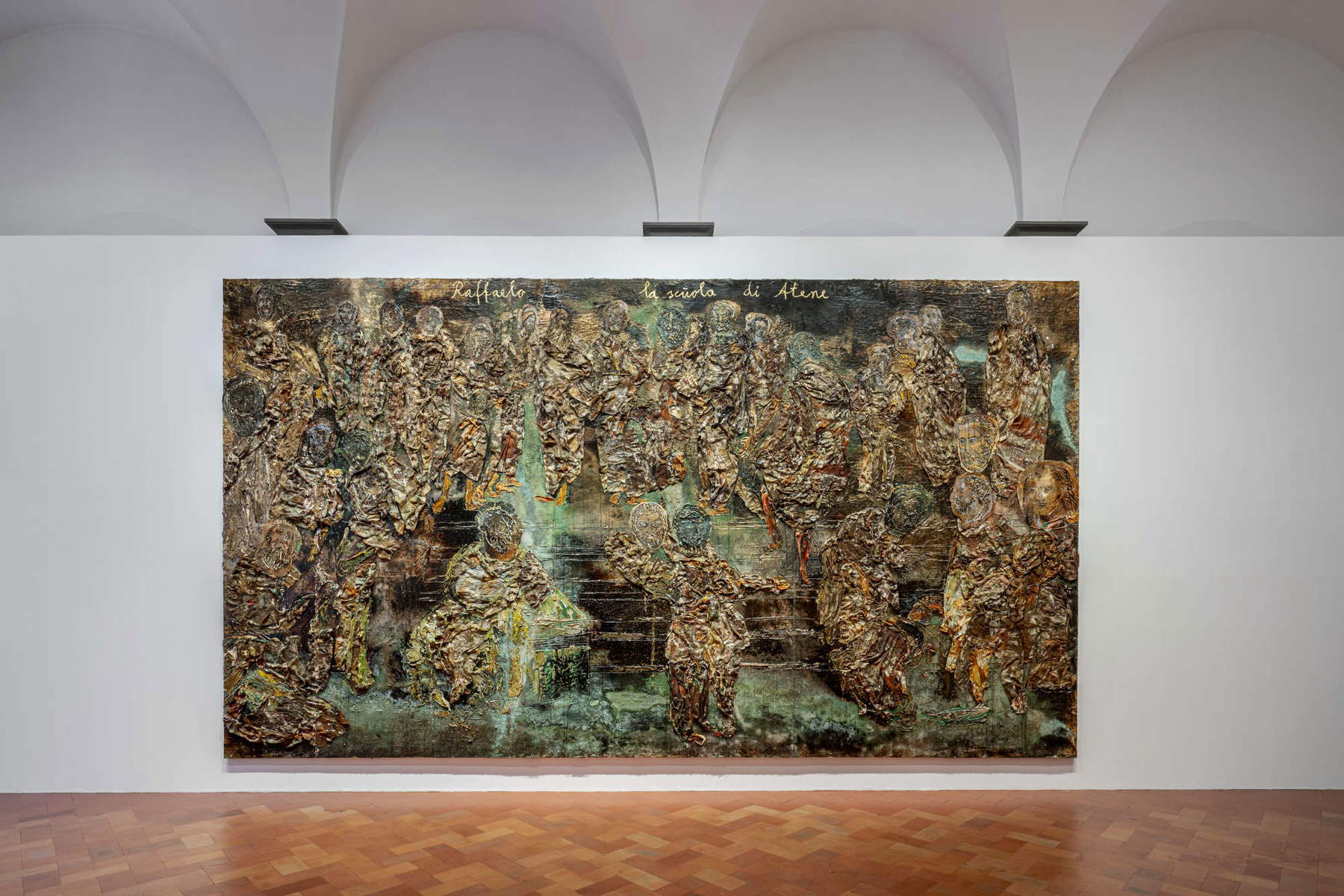
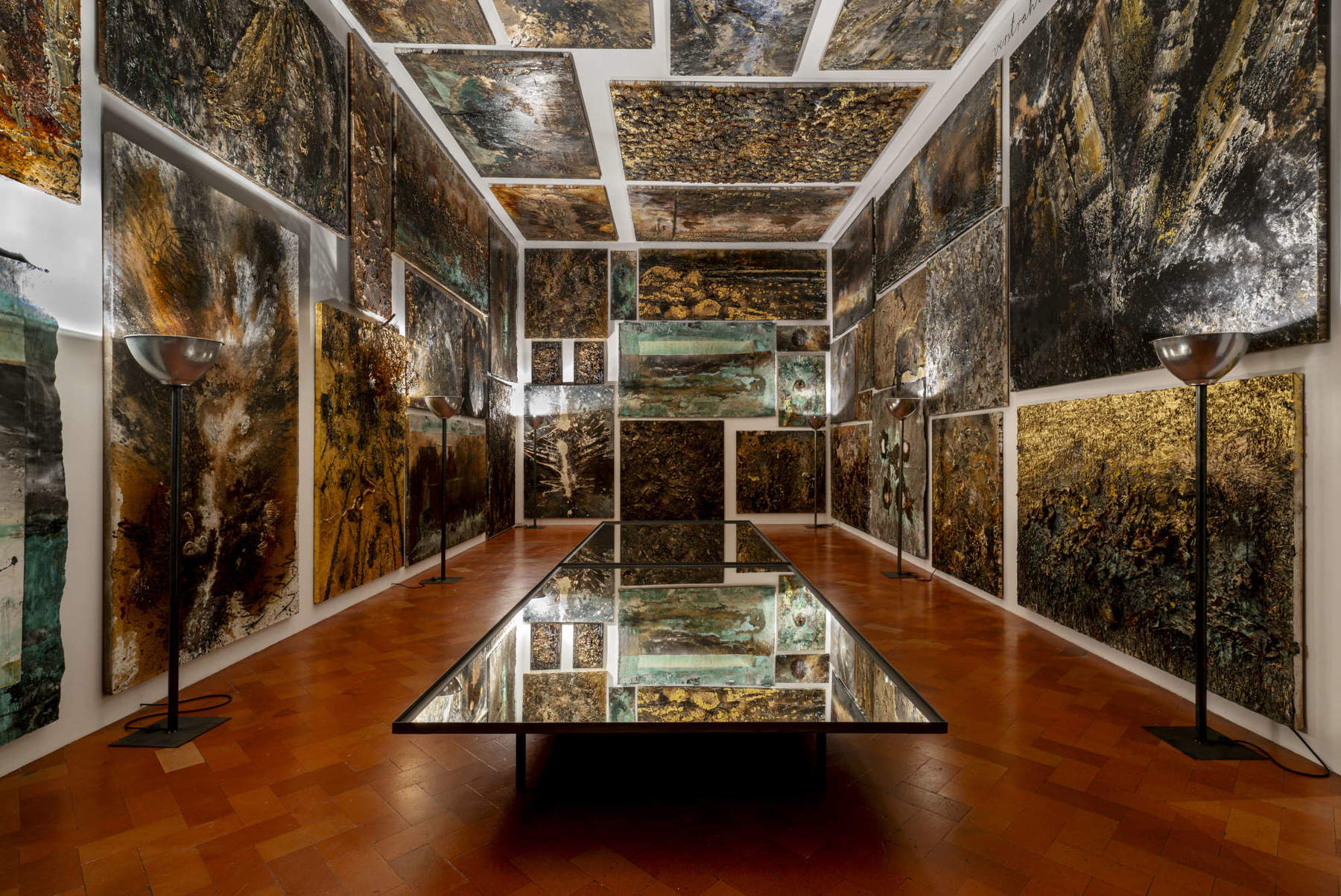
We then pass through an imposing room devoted to philosophy, in which three large canvases bear the faces of its greatest exponents from a plurality of cultures etched and molded into the pictorial material within solemn architectures, and aother room centered on sculptures under vitrines (which cannot help but call to mind the large display cases in the Auschwitz concentration camp where today the personal effects of deported Jews are kept, catalogued by type) in dialogue with other paintings more focused on his interest in the semantic and scenographic value of architecture. We then come to the environmental installation Vestrahlte Bilder (1983-2023), consisting of sixty paintings made over the past forty years, discolored by radiation and placed so as to occupy the walls and ceiling entirely by reverberating in a mirrored surface placed on the ground. The installation is emblematic of the artist’s ability to shape space with his imagination, which here takes the form of a synchronic pictorial continuum in which new signs and color castings link together works pertaining to different creative phases. One could spend an incalculable amount of time attempting to visually comprehend the whole or to analyze each painting in its singularity, but the overwhelming supremacy of painting transforms this experience into a leap into infinity that can be accessed only by indulging in a disorientation that closely resembles an act of faith.
Here we reach the culmination of a sensation that meanders throughout the visit, namely thecancellation of all spatial and categorical boundaries that puts us at the center of a mental universe whose stringent coherence we perceive, albeit governed by rules that exceed our rational horizon. It is from this point of view, finally, that we spoke at the outset of a successful symbiosis between the works and the historic building that houses them, no longer cited, evaded or forced into dialogue, but rewritten with a logic as totalizing as that with which it was originally conceived.
Warning: the translation into English of the original Italian article was created using automatic tools. We undertake to review all articles, but we do not guarantee the total absence of inaccuracies in the translation due to the program. You can find the original by clicking on the ITA button. If you find any mistake,please contact us.



























